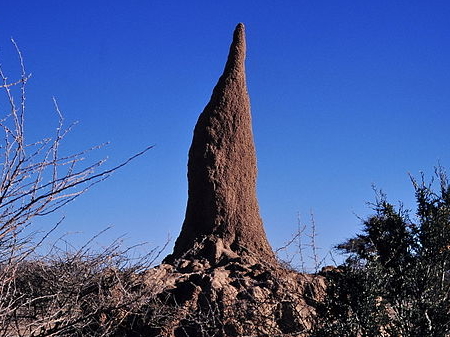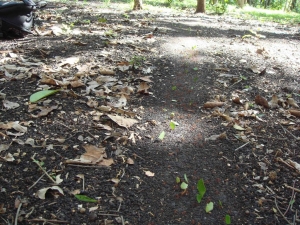When a column of marching army ants in Africa attacks a termite mound, remarkable things happen. The termite queen, who is a helpless, blob-like egg-laying machine, is rolled and pulled into a special chamber by her tenders and walled in. Soldier termites swarm out of the nest to engage the enemy, and worker termites seal off the entrances behind them. They will not be able to return. Win or lose, every one of them will die. They fight fearlessly, unquestioning, protecting a civilization they have built that might include wells that go down to the water table, ventilation shafts, galleries, fungus gardens and a royal chamber for the queen. The termite soldiers are several times bigger than the ants, with huge mandibles, but the ants swarm, and attack the extremities, grabbing the hind legs and the antennae, and holding them down for the hoard to kill.
The march of the army ants is a scorched-earth rampage. Scouts out ahead of the column paint any prey animal they find with a pheromone that triggers attack by the rest of the swarm. They kill and eat mostly other small invertebrates but can bring down bigger animals including rodents and even human beings. When they attack a termite colony their goal is to kill the queen so they can abscond with all the eggs. They cross watercourses and gaps in the landscape by creating swinging bridges with their interlinked bodies, which Susan and I have witnessed in the Yucatan Peninsula in Mexico. When the army rests, they create “bivouacs” with their bodies, sheltering the queen.
And what’s remarkable about all this? It’s that any one of these creatures only has a neural junction box for a brain. Each individual only follows a small set of rules and cues. Where does the intelligence come from? Is it even intelligence? Do we need to redefine the term?
In the scientific community the phenomenon goes by several names: collective intelligence, emergence, agent-based models, stigmergy. Each “agent” leaves a trace of its action in the environment, and that triggers a further action by another agent, and what emerges is a whole that is greater—more complex and more intelligent—than the sum of its parts.
The leafcutter ants in Central America (Acromyrmex and Atta spp) are thought to be the most complex societies on earth next to humankind. Susan and I shot this photo of them in the Yucatan. The columns march for hundreds of yards, threading through all the trees in the forest. Susan was asking a good question: Look around you, she said—there are trees everywhere! Why are they marching all over the place for their leaves?
What leafcutter ants do with those leaves is grow fungus gardens. The fungus they grow is in the Lepiotaceae family, and it’s a complete, two-way symbiosis—neither ant nor fungus can survive without the other. If there’s a leaf in the mix that messes up the fungus growth, they detect it and stop gathering it, and they range far afield to collect just the right mix of leaves. The plants, in turn, detect the attack and start producing “volatile organic chemicals” which are among other things fungicidal, and the ants are selective as they forage and avoid these leaves. Their fungus gardens include a “nursery” where they experiment with different mixes of leaves, and when they find a leaf that grows the fungus well, from a tree which has not yet mustered its chemical defenses, they remember exactly which tree those leaves came from, and columns of ants seize the moment and maraud that way, stripping it of all the leaves they can before it wises up.
But their astonishing “intelligence” does not stop there. A mold called Escovopsis is constantly threatening their crop, and the ants have a bacteria growing on their exoskeletons called Actinobacteria which secretes an antibiotic which fights it. I’m not making this up—these ants invented antibiotics twelve million years ago. Not only that, but throughout that time, they have somehow prevented Escovopsis from becoming resistant to the antibiotic, a feat medical science has not been able to pull off yet.
Their nest mounds can be 100 feet across and extend 18 feet into the ground, and the colonies can contain eight million individuals, so as with any urbanized civilization, waste management is a problem. They maintain a garbage heap, constantly working and shuffling it to keep it decomposing (this is done by the older, less useful worker ants—the young ones in their prime are indoors, at work in the fungus gardens). They place the heap above ground at a location which is equidistant from all hive entrances, to prevent contamination, and that constitutes solving a geometric problem. They can find the shortest route to a source of leaves, which constitutes solving a geographic problem. And they routinely shore up walls and colony entrances so that they don’t collapse, which constitutes solving an engineering problem.
It’s not just naturalists who study this stuff. Computer scientists and industrial engineers look at it: How can you create a complex system with a simple set of instructions? Experts in crowd handling look at ant behavior, and so do traffic flow experts. Two-way traffic lanes can be observed in ant trails, and people who have to devise the crowd handling at concerts so that stampedes are prevented, study the ants. A systems analyst at Southwest Airlines named Douglas Lawson modeled ant behavior to figure out how most efficiently to get people onto an airplane. He knew that ants are the experts at doing complex things by following simple instructions. (The answer: Open seating. It’s why Southwest uses it.) Research by humankind’s brightest minds is going on every day, but the ants, it seems, have it figured out. And they have figured it out without anything you could call a brain.
What is intelligence, anyway?
Just looking at my own species—and my own life—I have to say that I feel a connection to these societies of insects. The wisdom of the hive is, I think, very real for us as well. I have spent a fair amount of my life looking for wise men and gurus, and I have decided that there are none. The wisdom, I think, lives in the spaces between us. It is not individual, it is synergistic. It is the back side of our human tapestry, binding us together in ways that we do not see.
I am just dying to know: What is the big problem we are solving, which our brains are not even capable of understanding?



Amen.
Thanks, Andi, that’s a provoking thought! If we could get our sh*t together and act collectively (and selflessly), there’s probably no end to what we could accomplish!
After reading this it got me thinking….. (Which I’m asuming is the reason you blog) if intelligences are at that level in an organism smaller than most finger nails then human intelligence has some tough competition we need to step it up. If a army of ants can take over a mound with one fell swoop then I believe humans if bound together could make a difference not only in their own mound but in others transforming they way we interact. Maybe a solution to.war, poverty, and more……? Thanks uncle for pushing the envelope to thought.
Thanks, little Bro!
Yeah, someday I’d like to do a piece on human abstracts in general. The natural sciences are just full of them. Dad used to quote someone (one of the Huxleys? I’ll look it up…) saying, “We must remember that nature is not divided into disciplines the way universities are.”
Brilliant piece, big bro.
Steinbeck asked similar questions (what is an individual?) when exploring the Sea of Cortez with Doc Rickets. There is much about existence that we fail to comprehend because we want to classify things; life is far too imaginative and diverse to comply.
“Species”, says our genetic research buddy Dr. John Weihausen, “is a human abstract.”
I think we can say the same of intelligence.